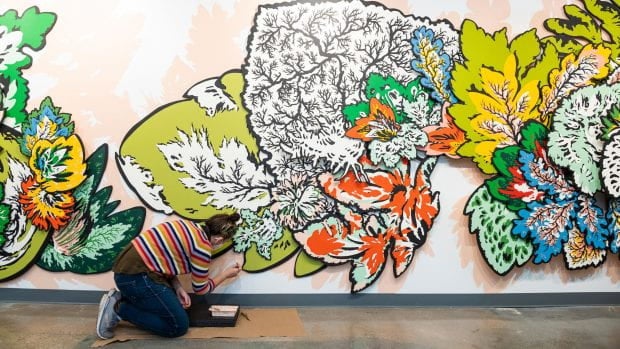There is a dense jungle of fresh foliage covering the wall of the first-floor corridor in Rice’s recently renovated M.D. Anderson Biological Laboratories building. But these fantastical flowers will never need to be watered. Made of highly durable wood and painted with equally durable paint, they’re the latest Rice Public Art installation: “Power Flower” by Natasha Bowdoin, associate professor of painting and drawing in the Department of Visual and Dramatic Arts (VADA).
Not only is “Power Flower” the first piece of Rice Public Art created and installed by a current Rice professor, Bowdoin’s installation is one of four new acquisitions made this year by the program — and they’re all from female artists.
“We are delighted to add four new works by leading women artists to the campus art collection,” said Alison Weaver, the Suzanne Deal Booth Executive Director of the Moody Center, who oversees the Rice Public Art program. “Natasha’s work was selected by a committee of faculty and staff working in Anderson to reflect the innovative research and learning that takes place in its classrooms and laboratories.”
Additional sculptures from Shirazeh Houshiary, Beverly Pepper and Pae White will be installed throughout the spring semester: Houshiary’s “Seif” outside the new Sid Richardson College, Pepper’s “Occam’s Wedge” adjacent to the Brockman Hall for Opera and White’s “Triple Virgo” inside McNair Hall. They join pieces in the Rice Public Art program by James Turrell, Sol LeWitt, Jaume Plensa, Jesús Moroles, Mark di Suvero, Ursula von Rydingsvard and many others spread across campus.
There’s a neat symmetry to Bowdoin’s work appearing in a biosciences building. Her creations resemble natural forms like lungs and plant leaves. It’s even common, she said, for people looking at her pieces to try and figure out what they’re based on — but nothing is actually a true copy of anything found in nature. Instead, the exaggerated sci-fi “foliage” is a hybrid, informed by the natural world but also born from Bowdoin’s brain, rendered in ultrasaturated hues with a pop art punchiness.
“I do think it sometimes befuddles people when they can’t place it in the real world, but that’s the beauty of art,” Bowdoin said. “You don’t have to be beholden to the real world’s limitations.”
Her blooms might also be familiar to those who remember her “Sideways to the Sun” installation, created for the spring 2019 exhibition at Rice’s Moody Center for the Arts. Climbing the walls and creeping across the floor, “Sideways to the Sun” sprawled across the bright, sunlit Central Gallery.
“Power Flower” is situated in a similarly sunny space and once again fronted by large windows, its rich palette drawing the eye inside from across a cozy courtyard. But unlike that Moody piece — parts of which could be moved around the gallery to interact with works by other visiting artists — these “plants” are permanent.
While much of her collage work is made from cut paper, Bowdoin used a computer numerical control router to cut these pieces — 50 to 60, she estimated — out of heavy-duty plywood. She then painted them with her studio assistant, Wiess College senior Sarah Easley (who's double-majoring in VADA and political science), and attached them to the wall with adjustable bolts custom 3D-printed for the task.
“These aren’t going anywhere,” Bowdoin said, laughing as she tugged at one of the colorful pieces. On a day during which the bright pink tulip tree outside was in full bloom, Bowdoin was putting the final touches on “Power Flower” ahead of its Feb. 12 debut. She’s been meditating its permanence — something meant to last as long as the majestic live oak whose massive branches sweep the ground of the courtyard.
“What am I going to think about this when I look at it 20 years from now?” said Bowdoin, whose sculptures are often site-specific and implicitly impermanent, as with her current show, “In the Night Garden,” at the Amon Carter Museum of American Art in Fort Worth. “It's kind of a weird and wonderful question, and a great opportunity to be able to revisit the work over time.”
In the meantime, “Power Flower” has already transformed a once-plain corridor into a destination. It’s easy to imagine people tucked into the snug chairs that line the hall, studying amid the inviting greenery and drawing inspiration from its once-out-of-nature exuberance.
“Natasha’s focus on the natural world through the lens of the human imagination adds a dynamic element to the building, and embodies the kind of energy public art can bring to campus,” Weaver said. “We look forward to sharing more visionary new works with the Rice community in the months ahead."


